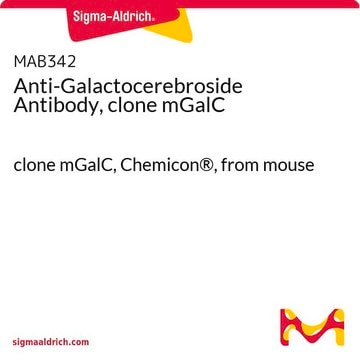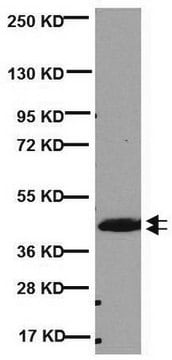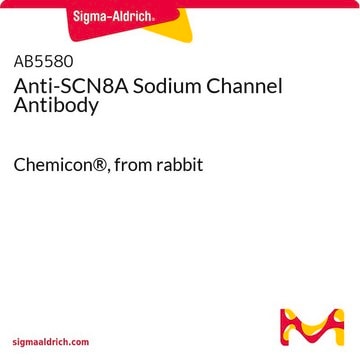MAB326
Anti-CNPase Antibody, clone 11-5B
clone 11-5B, Chemicon®, from mouse
Sinonimo/i:
2′3′-Cyclic Nucleotide 3′-Phosphohydrolase
Scegli un formato
684,00 €
Spedizione prevista il17 aprile 2025Dettagli
Scegli un formato
About This Item
684,00 €
Spedizione prevista il17 aprile 2025Dettagli
Prodotti consigliati
Origine biologica
mouse
Livello qualitativo
Forma dell’anticorpo
purified immunoglobulin
Tipo di anticorpo
primary antibodies
Clone
11-5B, monoclonal
Reattività contro le specie
canine, sheep, mouse, pig, bovine, rat, rabbit, human
Non deve reagire con
guinea pig, chicken
Produttore/marchio commerciale
Chemicon®
tecniche
immunocytochemistry: suitable
immunohistochemistry (formalin-fixed, paraffin-embedded sections): suitable
western blot: suitable
Isotipo
IgG1
N° accesso NCBI
N° accesso UniProt
Condizioni di spedizione
wet ice
modifica post-traduzionali bersaglio
unmodified
Informazioni sul gene
human ... CNP(1267)
Descrizione generale
Immunohistochemical localization of CNPase has shown the enzyme to be restricted to oligodendrocytes and Schwann cells. The enzyme appears to be distributed in single and double loose wraps of myelin and not in compact myelin as earlier thought by most investigators. CNPase is located on the inner and outer loops of myelin, paranodally and near the inner surface of the oligodendrocyte membrane. In plaque regions of multiple sclerosis patients, the enzyme is reduced, and when CNS myelin is decreased, CNPase is one of the earlier proteins to be lost from the myelin. In addition, an enzyme that is probably identical to brain CNPase is located in the outer rod segments within the visual system, and this protein is also recognized by the monoclonal antibody 11-5B. In mixed human gliomas, the enzyme levels are reduced, although about 5% of the oligodendrocytes occasionally show normal positive staining.
Specificità
Immunogeno
Applicazioni
A previous lot was used on primary oligodendrocyte cultures.
Immunohistochemistry:
A previous lot was used on rat hippocampus tissue and rat spinal cord.
Immunoblotting of myelin, the Wolfgram protein fraction, the SN4 fraction, tissue sections and mixed glial tumors (oligodendrogliomas, etc.) CNPase I (46 kDa) and CNPase II (48 kDa), which are differentially regulated during development, with the larger protein being expressed earlier than CNPase I during development.
Immunohistochemistry on both fresh frozen and paraffin embedded tissue (microwave pretreatment, ctirate pH 6.0).
Immunoblot:
Immunoblotting of myelin, the Wolfgram protein fraction, the SN4 fraction, tissue sections
and mixed glial tumors (oligodendrogliomas, etc.)
Optimal working dilutions must be determined by end user.
Neuroscience
Neuronal & Glial Markers
Qualità
Western Blot Analysis:
1:1000 dilution of this lot detected CNPASE on 10 μg of Mouse Brain lysates.
Descrizione del bersaglio
Stato fisico
Stoccaggio e stabilità
Risultati analitici
Western Blot: Fresh bovine whole brain extract, mouse brain lysate.
Immunohistochemistry: Rat hippocampus tissue, rat spinal cord tissue.
Altre note
Note legali
Esclusione di responsabilità
Non trovi il prodotto giusto?
Prova il nostro Motore di ricerca dei prodotti.
Raccomandato
Codice della classe di stoccaggio
10 - Combustible liquids
Classe di pericolosità dell'acqua (WGK)
WGK 2
Certificati d'analisi (COA)
Cerca il Certificati d'analisi (COA) digitando il numero di lotto/batch corrispondente. I numeri di lotto o di batch sono stampati sull'etichetta dei prodotti dopo la parola ‘Lotto’ o ‘Batch’.
Possiedi già questo prodotto?
I documenti relativi ai prodotti acquistati recentemente sono disponibili nell’Archivio dei documenti.
Filtri attivi
Il team dei nostri ricercatori vanta grande esperienza in tutte le aree della ricerca quali Life Science, scienza dei materiali, sintesi chimica, cromatografia, discipline analitiche, ecc..
Contatta l'Assistenza Tecnica.








